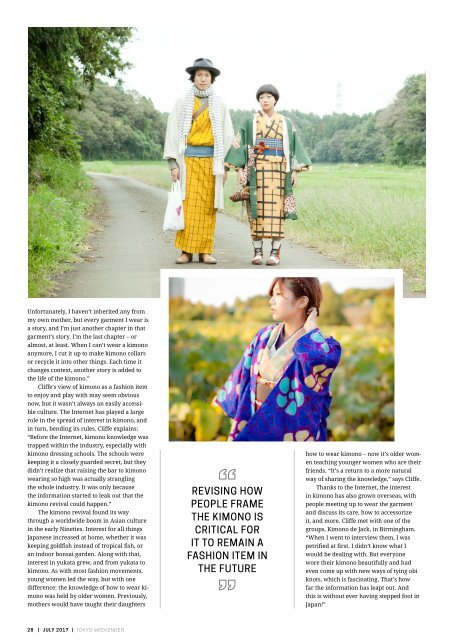Tokyo Weekender July 2016
Breaking the rules of kimono – a new book shatters antiquated views of this traditional garment. Plus: The boys for sale in Shinjuku Ni-chome, best sake of 2017, Japan's new emperor, and what really goes on inside "Terrace House."
Breaking the rules of kimono – a new book shatters antiquated views of this traditional garment. Plus: The boys for sale in Shinjuku Ni-chome, best sake of 2017, Japan's new emperor, and what really goes on inside "Terrace House."
Create successful ePaper yourself
Turn your PDF publications into a flip-book with our unique Google optimized e-Paper software.
Unfortunately, I haven’t inherited any from<br />
my own mother, but every garment I wear is<br />
a story, and I’m just another chapter in that<br />
garment’s story. I’m the last chapter – or<br />
almost, at least. When I can’t wear a kimono<br />
anymore, I cut it up to make kimono collars<br />
or recycle it into other things. Each time it<br />
changes context, another story is added to<br />
the life of the kimono.”<br />
Cliffe’s view of kimono as a fashion item<br />
to enjoy and play with may seem obvious<br />
now, but it wasn’t always an easily accessible<br />
culture. The Internet has played a large<br />
role in the spread of interest in kimono, and<br />
in turn, bending its rules. Cliffe explains:<br />
“Before the Internet, kimono knowledge was<br />
trapped within the industry, especially with<br />
kimono dressing schools. The schools were<br />
keeping it a closely guarded secret, but they<br />
didn’t realize that raising the bar to kimono<br />
wearing so high was actually strangling<br />
the whole industry. It was only because<br />
the information started to leak out that the<br />
kimono revival could happen.”<br />
The kimono revival found its way<br />
through a worldwide boom in Asian culture<br />
in the early Nineties. Interest for all things<br />
Japanese increased at home, whether it was<br />
keeping goldfish instead of tropical fish, or<br />
an indoor bonsai garden. Along with that,<br />
interest in yukata grew, and from yukata to<br />
kimono. As with most fashion movements,<br />
young women led the way, but with one<br />
difference: the knowledge of how to wear kimono<br />
was held by older women. Previously,<br />
mothers would have taught their daughters<br />
REVISING HOW<br />
PEOPLE FRAME<br />
THE KIMONO IS<br />
CRITICAL FOR<br />
IT TO REMAIN A<br />
FASHION ITEM IN<br />
THE FUTURE<br />
how to wear kimono – now it’s older women<br />
teaching younger women who are their<br />
friends. “It’s a return to a more natural<br />
way of sharing the knowledge,” says Cliffe.<br />
Thanks to the Internet, the interest<br />
in kimono has also grown overseas, with<br />
people meeting up to wear the garment<br />
and discuss its care, how to accessorize<br />
it, and more. Cliffe met with one of the<br />
groups, Kimono de Jack, in Birmingham.<br />
“When I went to interview them, I was<br />
petrified at first. I didn’t know what I<br />
would be dealing with. But everyone<br />
wore their kimono beautifully and had<br />
even come up with new ways of tying obi<br />
knots, which is fascinating. That’s how<br />
far the information has leapt out. And<br />
this is without ever having stepped foot in<br />
Japan!”<br />
28 | JULY 2017 | TOKYO WEEKENDER
















